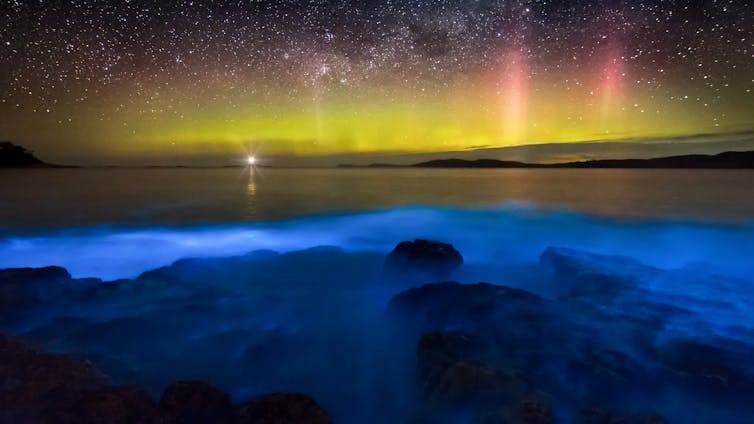- Wēouthir👋🏾
- Posts
- What is bioluminescence and how is it used by humans and in nature?
What is bioluminescence and how is it used by humans and in nature?
We now know, however, that bioluminescence has evolved independently at least 40 times on land and in the sea.

The sea was luminous in specks and in the wake of the vessel, of a uniform slightly milky colour. When the water was put into a bottle, it gave out sparks…
This is the first entry in Charles Darwin’s zoological notebook, written while he was aboard the Beagle just off the coast of Tenerife, on January 6, 1832. What Darwin saw was bioluminescent sea creatures, flickering light in response to physical disruption.
Bioluminescence, the production and emission of light by living organisms, became a sticking point for Darwin. He struggled to explain why this phenomenon appeared in separate species in a seemingly random fashion. We now know, however, that bioluminescence has evolved independently at least 40 times on land and in the sea.
Darwin was not the first to note bioluminescence. Greek philosopher Aristotle observed that bioluminescence is a type of “cold” light – in that it does not produce heat – in around 350 BC. Researchers have since found that this form of chemiluminescence, produces blue-green light as a result of the oxidation of a compound called luciferin (the “light-bringer”) by an enzyme called luciferase.
More than 75% of deep-sea creatures are estimated to produce their own light. The anglerfish, for example, uses bioluminescent lures, resembling fishing rods, to attract prey towards their large mouths. Intriguingly, the anglerfish’s light is actually produced by Photobacterium, a bacterium that lives in symbiosis with the fish inside its esca (lure).
The nocturnal Hawaiian bobtail squid – Euprymna scolopes – which lives in shallow waters, also has a symbiotic relationship with a bioluminescent bacterium, Aliivibrio fischeri. At night, these bacteria begin to glow, and the squid uses their light to camouflage itself against the night sky. This counter-illumination strategy is akin to an invisibility cloak.
At dawn, the squid expels around 95% of the glowing bacteria from its light organ, and supplies the remaining 5% with enough nutrients to grow throughout the day. A critical mass is reached once again by dusk, at which point the light switches on.
It was the study of this bacterium that led to the discovery of a microbiological phenomena called “quorum sensing”. This “chemical language” is used by Aliivibrio fischeri to count its neighbours. Doing this ensures that no energy is wasted in turning bioluminescent genes on before there are enough cells present in the squid’s light organ (typically around 10m cells per millilitre).
Closer to the sea surface, bioluminescence is commonly generated by a plankton called Noctiluca scintillans, known as “sea sparkle”. This microscopic organism produces flashes of light in response to physical disturbances as waves break on the shore, or when a stone is thrown into the bloom. The bioluminescent reaction in response to stimulus is termed the “burglar alarm” effect. When under attack by a predator, the collective flash of light startles the attacker and gives away its position, alerting higher predators of its whereabouts.
Bioluminescence and humans
Throughout history, humans have devised ingenious ways of using bioluminescence to their advantage. Glowing fungi have been used by tribes to light the way through dense jungles, for example, while fireflies were used by miners as an early safety lamp. Perhaps inspired by these applications, researchers are now again turning to bioluminescence as a potential form of green energy. In the not so distant future, our traditional street lamps may be replaced by glowing trees and buildings.
Today, bioluminescence from Aliivibrio fischeri is used to monitor water toxicity. When exposed to pollutants, light output from the bacterial culture decreases, signalling the possible presence of a contaminant.
Bioluminescence has even played a part in warfare. Bioluminescent organisms aided in the sinking of the last German U-boat during World War One, in November 1918. The submarine is reported to have sailed through a bioluminescent bloom, leaving a glowing wake which was tracked by the allies.
It has had a protective role too. In the aftermath of one of the bloodiest battles of the American Civil War, at Shiloh, the wounds of some of the injured soldiers began to glow. These glowing wounds healed more quickly and cleanly, and the phenomenon became known as “Angel’s Glow”. The glow was probably produced byPhotorhabdus luminescens, a soil-dwelling bacterium which releases antimicrobial compounds and so protected the soldiers from infection.
It is perhaps the medical applications of bioluminescence that have attracted the most excitement. In 2008, the Nobel Prize in Chemistry was awarded for the discovery and development of green fluorescent protein (GFP). GFP is found naturally in the crystal jellyfish Aequorea victoria, which, unlike the bioluminescence mechanism described so far, is fluorescent. This means that the protein needs to be excited by blue light before emitting its characteristic green light. Since its discovery, GFP has been genetically inserted into various cell types and even animals to shed light on important aspects of cell biology and disease dynamics.
The evolutionary process that culminated in bioluminescence may have taken million of years, but its scientific applications continue to revolutionise our modern world. Remember that, the next time you see the sea sparkle.![]()
Catrin F. Williams, Research Fellow, Cardiff University
This article is republished from The Conversation under a Creative Commons license. Read the original article.
Reply